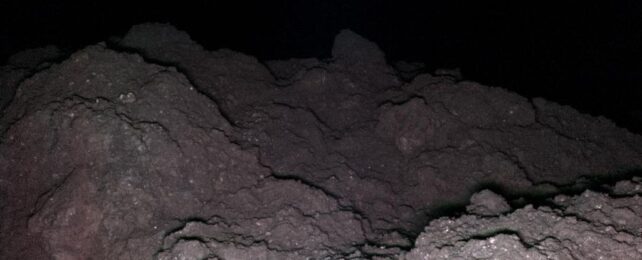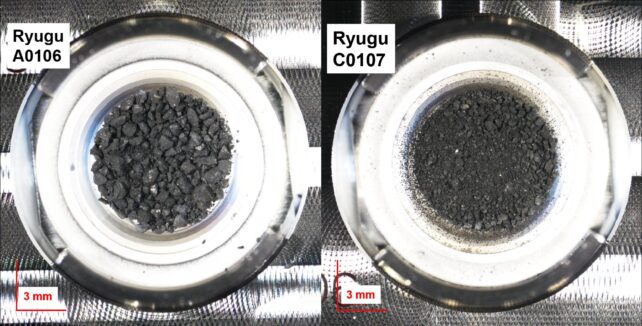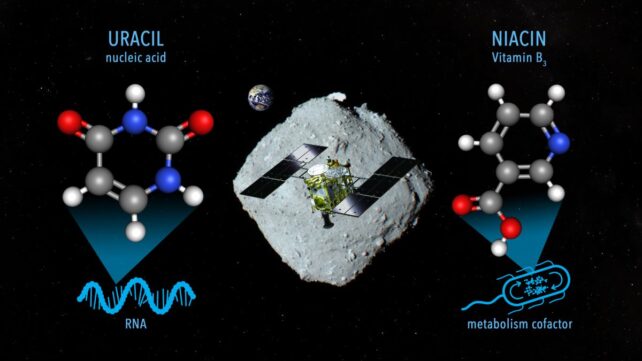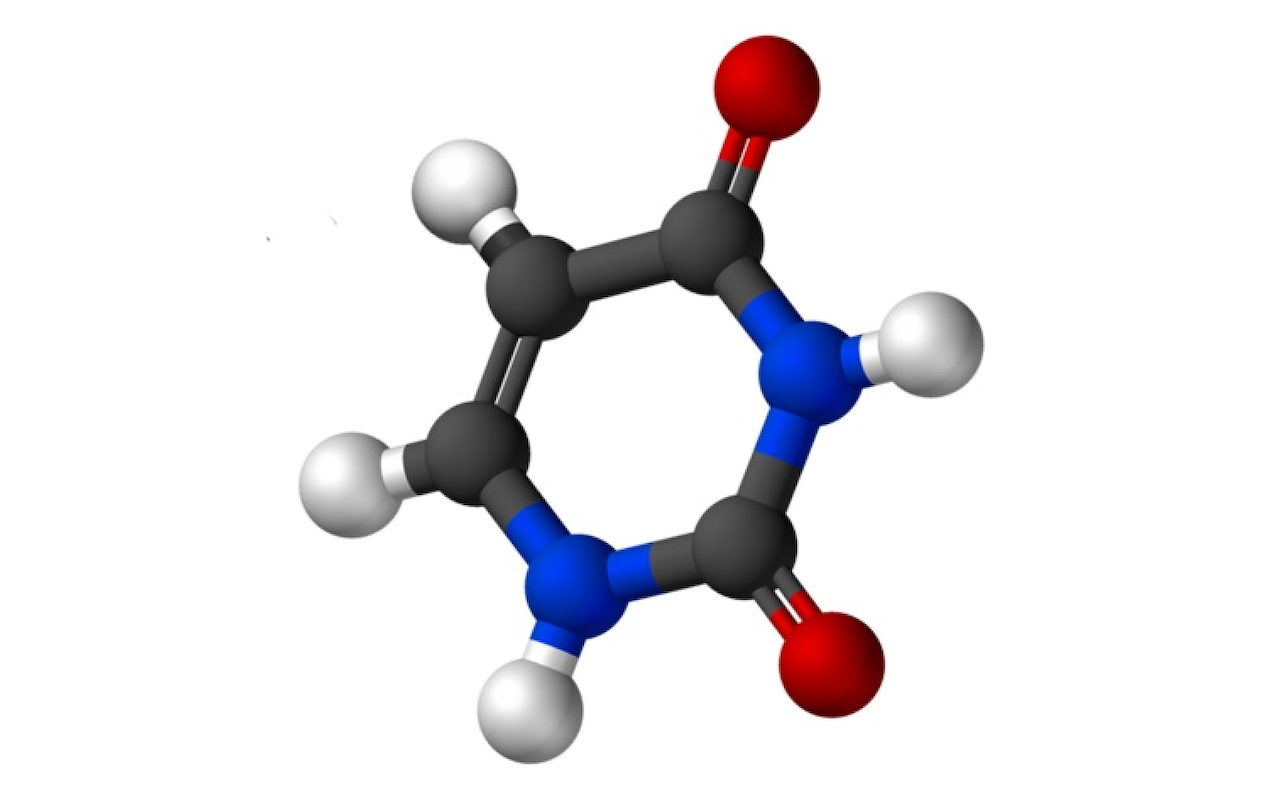Scientists Discover RNA Component Buried in The Dust of an Asteroid

A sample extracted from an asteroid far from Earth has confirmed that RNA nucleobases can be found in space rocks.
Analysis of dust ferried home from asteroid Ryugu has been found to contain uracil – one of the four nucleobases that make up RNA – in addition to niacin, a form of the vitamin B3, which plays an important role in metabolism.
This adds to a growing body of evidence that the building blocks for life form in space, and may have been at least partially delivered to Earth by asteroid bombardment early in our planet's history.
"Scientists have previously found nucleobases and vitamins in certain carbon-rich meteorites, but there was always the question of contamination by exposure to the Earth's environment," says astrochemist Yasuhiro Oba of Hokkaido University in Japan.
"Since the Hayabusa2 spacecraft collected two samples directly from asteroid Ryugu and delivered them to Earth in sealed capsules, contamination can be ruled out."
How life emerged, and how common that emergence might be across the Milky Way galaxy, are two questions that humanity would love to know the answers to. One way to interrogate them is to seek the building blocks of life in space, and explore potential mechanisms for their delivery from out there to down here.
As we are increasingly discovering, the building blocks for life out there are plentiful. They've been spotted in planet-forming dust, and in the clouds of star-forming dust that shroud the heart of our galaxy. And they've been found in multiple meteorites that have penetrated Earth's atmosphere and fallen to ground.
Put together, the evidence suggests that life's building blocks may indeed have been alien… but certainty remained elusive until scientists could rule out the permeation of Earth material into space rocks after their arrival here.
To figure out what was in the pristine samples Hayabusa2 brought back from Ryugu, Oba and his colleagues employed a new technique they developed for the small-scale detection and identification of nucleobases in tiny amounts.

The team took the two samples, obtained from different locations on the asteroid, soaked them in hot water, and subjected them to high-performance liquid chromatography coupled with electrospray ionization high-resolution mass spectrometry. This technique, when employed on the Murchison meteorite that fell to Earth in 1969, yielded all five canonical nucleobases.
The range of biomolecules found in Ryugu was smaller, but still significant, the researchers believe.
"We found uracil in the samples in small amounts, in the range of 6–32 parts per billion (ppb), while vitamin B3 was more abundant, in the range of 49–99 ppb," Oba says. "Other biological molecules were found in the sample as well, including a selection of amino acids, amines and carboxylic acids, which are found in proteins and metabolism, respectively."

The compounds identified, which join around 20 amino acids previously found in Ryugu samples, differ from those found in other carbon-rich meteorites that have fallen to Earth, but are broadly similar. This suggests that biomolecules may be quite common in carbonaceous meteorites, and could have hitched a ride to Earth during periods of bombardment.
As to how they got on the asteroids, scientists believe that compounds containing nitrogen may have formed from simpler molecules, including formaldehyde, ammonia, and hydrogen cyanide.
These have not been found in the Ryugu samples, but they were likely present if, early in its history, the asteroid or its parent body had been a comet, coated in ices rich in these molecules.
Ryugu, however, is just the beginning. NASA has collected a sample from another asteroid, Bennu, and is ferrying it home to Earth for analysis. Early studies indicate that it, too, contains organic materials that are consistent with the building blocks of life.
"The discovery of uracil in the samples from Ryugu lends strength to current theories regarding the source of nucleobases in the early Earth," Oba says.
"The OSIRIS-REx mission by NASA will be returning samples from asteroid Bennu this year, and a comparative study of the composition of these asteroids will provide further data to build on these theories."
It seems the star stuff we're made of took a detour by way of asteroids.
The research has been published in Nature Communications.
Uracil Has Been Found In Asteroid Ryugu Samples

Researchers have analyzed samples of asteroid Ryugu collected by the Japanese Space Agency’s Hayabusa2 spacecraft and found uracil—one of the informational units that make up RNA, the molecules that contain the instructions for how to build and operate living organisms. Nicotinic acid, also known as Vitamin B3 or niacin, which is an important cofactor for metabolism in living organisms, was also detected in the same samples.
Uracil Has Been Found In Asteroid Ryugu, Nature (open access)
This discovery by an international team, led by Associate Professor Yasuhiro Oba at Hokkaido University, adds to the evidence that important building blocks for life are created in space and could have been delivered to Earth by meteorites. The findings were published in the journal Nature Communications.
“Scientists have previously found nucleobases and vitamins in certain carbon-rich meteorites, but there was always the question of contamination by exposure to the Earth’s environment,” Oba explained. “Since the Hayabusa2 spacecraft collected two samples directly from asteroid Ryugu and delivered them to Earth in sealed capsules, contamination can be ruled out.”
The researchers extracted these molecules by soaking the Ryugu particles in hot water, followed by analyses using liquid chromatography coupled with high-resolution mass spectrometry. This revealed the presence of uracil and nicotinic acid, as well as other nitrogen-containing organic compounds.
“We found uracil in the samples in small amounts, in the range of 6–32 parts per billion (ppb), while vitamin B3 was more abundant, in the range of 49–99 ppb,” Oba elaborated. “Other biological molecules were found in the sample as well, including a selection of amino acids, amines and carboxylic acids, which are found in proteins and metabolism, respectively.” The compounds detected are similar but not identical to those previously discovered in carbon-rich meteorites.
The team hypothesizes that the difference in concentrations in the two samples, collected from different locations on Ryugu, is likely due to the exposure to the extreme environments of space. They also hypothesized that the nitrogen-containing compounds were, at least in part, formed from the simpler molecules such as ammonia, formaldehyde and hydrogen cyanide. While these were not detected in the Ryugu samples, they are known to be present in cometary ice—and Ryugu could have originated as a comet or another parent body which had been present in low temperature environments.
“The discovery of uracil in the samples from Ryugu lends strength to current theories regarding the source of nucleobases in the early Earth,” Oba concludes. “The OSIRIS-REx mission by NASA will be returning samples from asteroid Bennu this year, and a comparative study of the composition of these asteroids will provide further data to build on these theories.”
Paper:
Yasuhiro Oba, et al. Uracil in the carbonaceous asteroid (162173) Ryugu. Nature Communications. March 21, 2023.
DOI: 10.1038/s41467-023-36904-3
Funding:
The Hayabusa2 project has been led by JAXA (Japan Aerospace Exploration Agency) in collaboration with DLR (German Space Center) and CNES (French Space Center) and supported by NASA (National Aeronautics and Space Administration) and ASA (Australian Space Agency). This research is partly supported by the Japan Society for the Promotion of Science (JSPS) under KAKENHI (21H04501, 21H05414, 21J00504, 21KK0062, 20H00202); the Consortium for Hayabusa2 Analysis of Organic Solubles, supported by NASA. This study was partly conducted by the official collaboration agreement through the joint research project with JAMSTEC, Keio University and HMT Inc. This study was conducted in accordance with the Joint Research Promotion Project at the Institute of Low Temperature Science, Hokkaido University (21G008, 22G008).
Astrobiology, Astrochemistry
No comments:
Post a Comment